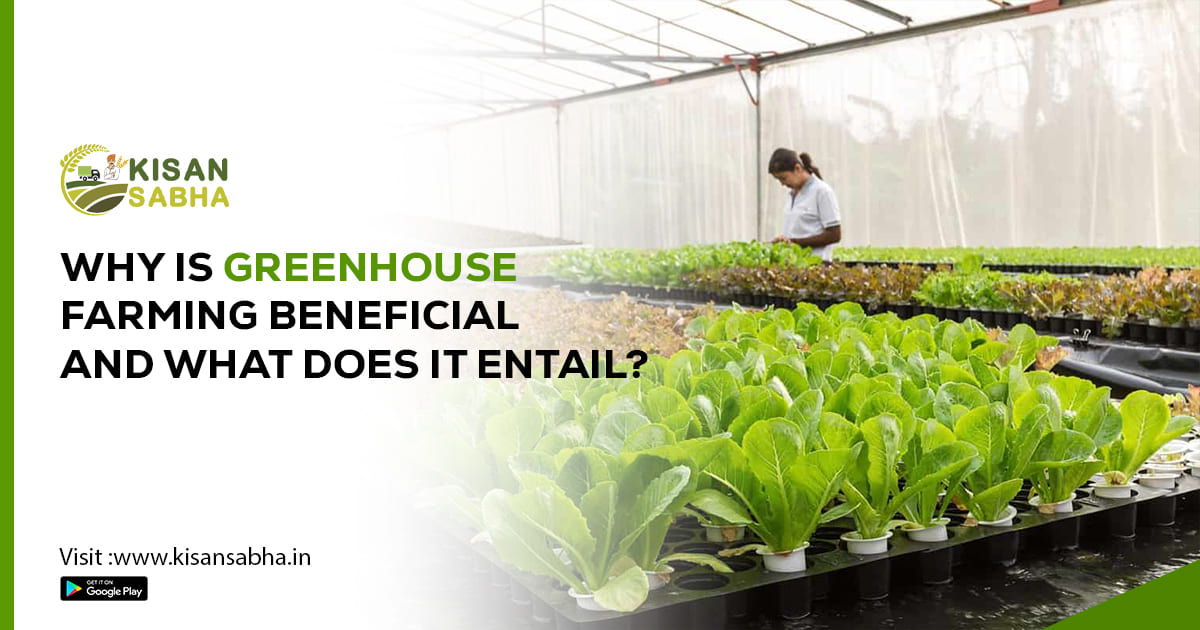India’s economic success depends heavily on agriculture. It is also accurate to mention that India’s greenhouse farming has shown some amazing technical advancements in the field of agriculture. Additionally, it is swiftly adopting numerous contemporary Agritech developments to make up for missed chances. Additionally, it increases agricultural output to a level that is comparable to many other nations that are global economic superpowers. Greenhouse farming is a cutting-edge and productive technique that improves the productivity, commercial viability, and sustainability of our main agricultural systems. This blog will also provide a comprehensive explanation covering the advantages of greenhouse farming.
Why is greenhouse farming beneficial ?
Greenhouse farming, also known as greenhouse cultivation and controlled-environment agriculture (CEA), involves producing plants in an enclosed structure, generally made of glass or plastic. Farmers can monitor and control climatic elements like light, humidity, and temperature in this enclosed environment.
Greenhouse agriculture provides a controlled environment where plants shelter from harsh weather, pests, and illnesses. Furthermore, growers can customize growth conditions within a greenhouse to meet the demands of different plant species, allowing for year-round cultivation of crops that would otherwise be unable to survive in the surrounding environment or season.
Greenhouse agriculture may produce a variety of items, including fruits, vegetables, herbs, and cut flowers.
The Major Benefits of Greenhouse Farming
Let’s take a closer look at the primary advantages of greenhouse farming.
- A greenhouse is an ideal environment for growing high-quality crops for export markets.
- Greenhouses provide the best opportunity within the restrictions of limited natural resources.
- As a result, greenhouses allow for the establishment of viable nurseries through vegetative or seed propagation.
- With greenhouse farming, high yields may be obtained with a little area of cultivation.
- Greenhouse horticulture can provide local employment for degree holders.
- As a result of frequent observation, several crops that are biologically more effective and disease-free are produced.
- Crop water requirements are lowered in greenhouses due to less transpiration and less unoccupied areas.
Types of Green Houses
Agriculture utilizes many different types of greenhouses, each featuring its own set of materials, technology, and internal machinery. The following are the most common greenhouse types used in agriculture.
ECO-FRIENDLY PLASTIC GREENHOUSES
Plastic greenhouses are the most popular since they offer several benefits. They are not only the cheapest but also the lightest material, allowing the use of load-bearing structures that are both simple to install and lightweight. Furthermore, this form of greenhouse is quite adaptable and can be outfitted with any type of system.
GLASS GREENHOUSES
Glass greenhouses are another excellent option for producing protected crops, plants, and veggies. Their key feature is their long-term durability: glass is a robust, durable, and resistant material that can be equipped with any sort of system. Glass greenhouses ensure maximum brightness and, owing to more sophisticated technology, allow for the creation of perfect circumstances for the growth of each plant and vegetable within them.
COMBILUX GREENHOUSES
Combilux technology is one of the most intriguing advancements in the horticulture greenhouses field. This is a highly technical greenhouse, with the major benefit being versatility in terms of size and materials.
HYDROPONIC GREENHOUSES
Another cutting-edge design that offers maximum efficiency in agricultural output while minimizing environmental effects is the hydroponic greenhouse. In actuality, this kind of greenhouse not only uses solar energy to sustain itself but also permits the development of plants above ground with an amazing reduction in water and fertilizer usage.
So Are greenhouse farms profitable?
In the long run, greenhouse vegetable farming is profitable, just like any other sort of long-term business. However, constructing a greenhouse is not done with the intention of profiting from it by 5 to 6 times. Instead, growing vegetables that cannot be grown in the same region or place is the main goal of the greenhouse. It is therefore very useful in agricultural wastelands.
However, it is accurate to say that producing vegetables in greenhouses is quite profitable in the long term. In the event that you obtain a greenhouse subsidy, the investment cost will be get lower. You will therefore be able to fast return your investment in the coming years. When you have earned back your whole investment in the greenhouse, you may make four to five times your typical investment.
On a larger scale, we might claim that impoverished farmers cannot succeed with greenhouse farming. For the greenhouse to perform greenhouse vegetable production for low-income farmers, even a 40% subsidy is insufficient.
Conclusion
Growing food in a greenhouse provides a number of benefits for both farmers and consumers. Greenhouses offer a controlled and effective environment for growing a variety of crops, including climate control, insect and disease protection, increased productivity, longer growing seasons, and higher-quality harvests.
By saving water, using fewer harmful chemicals, and using renewable energy sources, greenhouse farming also improves sustainability and energy efficiency. With the right preparation and execution, greenhouse farming can be both a profitable and satisfying undertaking for farmers as well as a source of nutritious, regionally grown veggies for consumers.




